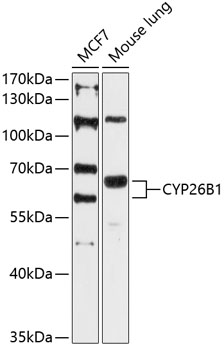-
Product Name
CYP26B1 Polyclonal Antibody
- Documents
-
Description
Polyclonal antibody to CYP26B1
-
Tested applications
WB
-
Species reactivity
Human, Mouse
-
Alternative names
CYP26B1 antibody; CYP26A2 antibody; P450RAI-2 antibody; P450RAI2 antibody; RHFCA antibody; cytochrome P450 26B1 antibody
-
Isotype
Rabbit IgG
-
Preparation
Antigen: Recombinant fusion protein containing a sequence corresponding to amino acids 213-512 of human CYP26B1 (NP_063938.1).
-
Clonality
Polyclonal
-
Formulation
PBS with 0.02% sodium azide, 50% glycerol, pH7.3.
-
Storage instructions
Store at -20℃. Avoid freeze / thaw cycles.
-
Applications
WB 1:500 - 1:2000
-
Validations

Western blot - CYP26B1 Polyclonal Antibody
Western blot analysis of extracts of various cell lines, using CYP26B1 antibody at 1:3000 dilution.Secondary antibody: HRP Goat Anti-Rabbit IgG (H+L) at 1:10000 dilution.Lysates/proteins: 25ug per lane.Blocking buffer: 3% nonfat dry milk in TBST.Detection: ECL Basic Kit .Exposure time: 90s.
-
Background
Involved in the metabolism of retinoic acid (RA), rendering this classical morphogen inactive through oxidation. Involved in the specific inactivation of all-trans-retinoic acid (all-trans-RA), with a preference for the following substrates: all-trans-RA > 9-cis-RA > 13-cis-RA. Generates several hydroxylated forms of RA, including 4-OH-RA, 4-oxo-RA, and 18-OH-RA. Essential for postnatal survival. Plays a central role in germ cell development: acts by degrading RA in the developing testis, preventing STRA8 expression, thereby leading to delay of meiosis. Required for the maintenance of the undifferentiated state of male germ cells during embryonic development in Sertoli cells, inducing arrest in G0 phase of the cell cycle and preventing meiotic entry. Plays a role in skeletal development, both at the level of patterning and in the ossification of bone and the establishment of some synovial joints.; Has also a significant activity in oxidation of tazarotenic acid and may therefore metabolize that xenobiotic in vivo.
Related Products / Services
Please note: All products are "FOR RESEARCH USE ONLY AND ARE NOT INTENDED FOR DIAGNOSTIC OR THERAPEUTIC USE"
